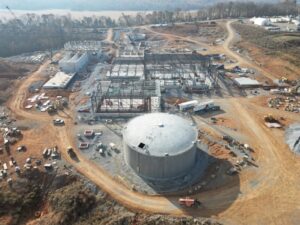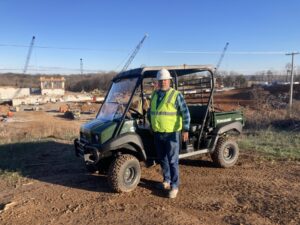A Day in the Life of a Resident Project Representative
Ever wondered what a resident project representative (RPR) does each day? One of our communications colleagues recently interviewed Jared Secondine, a RPR assigned to the North Clarksville Water Treatment Plant (NCWTP) project, to find out. Read along as he’s asked about his contributions to the project, what a typical day entails, and how he’s bringing value to the project.
What role does an RPR perform?
I’m on site to observe the construction that’s going on, ensuring the contractor is following the contract’s document specifications. I also help in reviewing submittals, work with the contractor on resolving RFI’s, and serve as a point person if further information is needed from various parties. I act as a liaison between the client, contractor, and SSR. On a project the size and scope of this one, having a representative on site can save a lot of time if and when field changes come up.
With Clarksville being a new plant, is there anything unique about that situation?

default
It is different. Much of my experience has been at existing plants that are undergoing renovation or expansion, and the client or operator is on site, but they’re focused on running the plant and keeping normal operations. While the plant is in construction, Clarksville has two representatives on site (the plant Superintendent and the plant operations manager), and they’re with me daily. It’s more client relations than I’m used to, but it’s a benefit to the project. They can act as a third set of eyes and point out things that will make their roles easier as the project moves into operation. They’re also available to make some selections and decisions quickly as things come up during construction.
Have you been on the Clarksville project since day 1?
Yes, I joined SSR specifically to work on the NCWTP. Before SSR, I had ten years of RPR experience, worked as a plant operator, and with a public works department in Nevada. I have a deep background in water plant operations and was on the utility side for the construction and opening of a new water treatment plant.
How does your role change on an existing plant vs new construction?
They’re very different. In an existing plant, most of the renovation or expansion work is done in phases. You can’t shut the plant down to do something; there’s a level of logistical planning and coordination. But on a new, greenfield site, we’re building a lot at the same time. For Clarksville, there’s two contractors on site, responsible for different elements of the project. I’m working with them both, making sure their work will line up in the end. There’s another RPR on site focused specifically on the raw water intake that I’m coordinating with.
What does a typical day look like for you?
 I’m here full time; if there’s construction going on, I’m here. It’s getting to the point in construction that we’ve got multiple subs on site daily, so I’m checking in with them – the plumbing and electrical contractors, painters, masons, etc. There’s a specialty concrete contractor here, so I’m constantly moving around the site checking in with those different groups across the project site making sure they have what they need and following up when needed. Most of the day I’m visiting different areas of the site, seeing what’s going on, verifying different things, noting any changes that need to be communicated either back to the office or to the client, and updating as-builts for Clarksville to have and be able to reference after construction is completed. As a former operator myself, it’s very important to me that the client has correct information once the project is completed.
I’m here full time; if there’s construction going on, I’m here. It’s getting to the point in construction that we’ve got multiple subs on site daily, so I’m checking in with them – the plumbing and electrical contractors, painters, masons, etc. There’s a specialty concrete contractor here, so I’m constantly moving around the site checking in with those different groups across the project site making sure they have what they need and following up when needed. Most of the day I’m visiting different areas of the site, seeing what’s going on, verifying different things, noting any changes that need to be communicated either back to the office or to the client, and updating as-builts for Clarksville to have and be able to reference after construction is completed. As a former operator myself, it’s very important to me that the client has correct information once the project is completed.
What’s the timeline for this project?
Currently, the target date for operations is likely Q1 2025 with water going into the system in mid-2025. There’s been a lot of delays between COVID and issues getting materials that delayed construction. And then once everything is completed, there’s a period of time necessary to get everything working efficiently and then more time getting water through the plant and adjusting the chemicals and flows before they’re able to start delivering water to the customer. I’ll be here through all of that to make sure everything is working properly and that everything on a punch list is completed.
About the North Clarksville Water Treatment Plant
Rapid industrial, commercial, and residential growth in the Clarksville area was expected to exceed the existing water treatment’s capacity quicker than anticipated. Clarksville Gas & Water decided to build a new plant to supplement their existing facility. Similar in design to the South Plant, the new 12 MGD plant incorporates the same technologies as the existing plant including coagulation, flocculation, sedimentation, and membrane filtration. One notable difference between the two plants is the inclusion of pressurized GAC contactors downstream of the membranes. The plant was designed to accommodate future expansions to 24 MGD and 36 MGD as Clarksville and the surrounding communities continue to grow.







